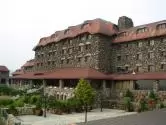Embarking On a Second Century

The Grove Park Inn is celebrating its 100th anniversary this month, commemorating the official grand opening which took place on Saturday night, July 12, 1913, with speeches, toasts, tours, and fireworks. On that first night one hundred years ago, four hundred of the most influential and prominent men of Southern politics, business, and industry were present for the stag dinner.
Why their wives were excluded from the evening’s banquet and speeches is beyond my comprehension, but I like to think they all might have gathered in the new Ladies’ Lounge to enjoy each other’s company, perhaps to light up a Virginia Slims. “Smoking may be offensive to some people”, a 1912 magazine article had declared, “but it encourages peace and morality.”
The headliner of the evening was four-time presidential candidate and Secretary of State William Jennings Bryan, who later built a home on a lot he purchased from Edwin Wiley Grove just below the Grove Park Inn.
Which is precisely what Grove had in mind when he first proposed building the Grove Park Inn. He calculated — quite accurately — that he could actually afford to lose money on the hotel by making even more money selling residential building lots on his 1200 acres of land surrounding it and the golf course. Which is precisely what happened.
Grove is often overlooked for a major accomplishment few people know about. At the time he built a summer home here, shortly after the turn of the century, a group of Asheville citizens were proposing that the city finance the construction of a national center for the treatment of tuberculosis. The city already had scores of unregulated boarding houses which catered to tuberculosis victims, including one owned by Tom Wolfe’s mother, so they argued that having one national center would actually improve the city.
E. W. Grove and others, however, warned against the likelihood that Asheville would become a modern day leper’s colony, shunned by tourists and residents alike until it became a virtual ghost town. When Grove threatened to cancel his plans to build the Grove Park Inn and return to his home in St. Louis, the tide of public opinion began to flow against the tuberculosis movement. Grove further emphasized his stance by inserting into the deed for any property he sold an eternal ban on any boarding house or tuberculosis sanitarium on that land. Those restrictions remain in force today.
Fred Seely, Grove’s son-in-law, managed the Grove Park Inn until 1928, making it clear he preferred three elements not be present: alcohol, children, and conventions. And for nearly two decades his formula worked — sometimes. When times got tough, he had to relent on conventions. When prominent guests brought their own moonshine, he had to look the other way.
And children? Fred built them a separate dining room in the basement, then constructed separate cottages for families, but finally had to relent. (Ironically, he had five children of his own.)
Today the Grove Park Inn has some of the finest convention facilities in the country, has its own private label beer and wine, loves families, and is even pet-friendly.
The Grove Park Inn is beginning its second century with a new owner, a new management team, and an extensive renovation program: a fresh look for the Great Hall, new carpeting throughout the hotel, refurbished guest rooms, and a new, separate bar and restaurant called Edison’s — after Thomas, a guest in 1918.
The Arts and Crafts Conference will return to the Grove Park Inn on February 21-23 for the 27th time, and we will be able to see, appreciate, enjoy and evaluate all of the changes of the past year.
I hope to see you there.

Until next Monday,
Have a great week!
Bruce
For updated information on the 27th National Arts and Crafts Conference, go to http://www.Arts-CraftsConference.com.
